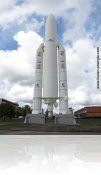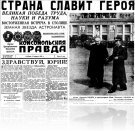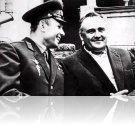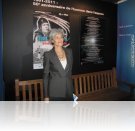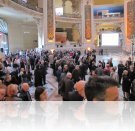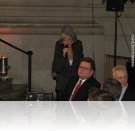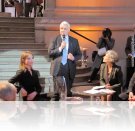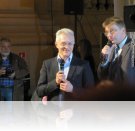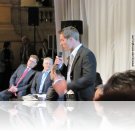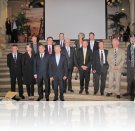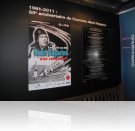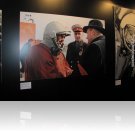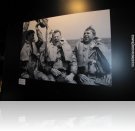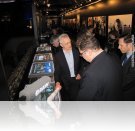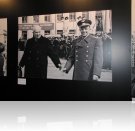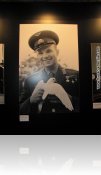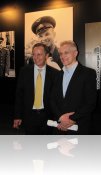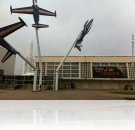Archives for the year 2011
Antonov still wants to complete the second Mriya

Antonov’s CEO, Kostiantyn Lushakov, declared to the press agency Interfax-Ukrain that 300 M$ were necessary to complete the construction of the second Antonov 225. If the fundings are given the assembly could be finished in 3 years.
According to Vyacheslav Boguslaev, chairman of the Motor Sich company, the Russian Defense’s minister Anatoly Serdukov is interested by the assembly of this second plane.
Source: ukrainianjournal.com
Posted on:
2011-05-13 under
Mriya.
Commentaires fermés
Space museum of Kourou
When I went to French Guyana in October/November 2009, in particular to visit the space center and to attend a launch of Ariane 5, I visited the space museum of Kourou. This museum is in fact near the technical center of the space base, few kilometers aways from the city.
It is mainly dedicated to the Ariane program and shows the evolution of this launcher through the years.
The visit begins here.
Launch of Ariane 5 V192 that I attended:

Posted on:
2011-04-15 under
Museum.
Commentaires fermés
50 years of human space flights
50 years ago day to day at 09h07 the Vostok rocket brought on board the first space traveler, Yuri Alekseyevich Gagarin. His flight was short (one orbit of 108 minutes), indeed nobody knew at that time how the human body will act in weightlesness, is it possible to breath, is it possible to drink… This is why the flight was to be the shortest possible. The Gagarin’s mission was to be the first to go to the unknown and simply see if men could live in weightlesness, thus, his first words were « I’m feeling ok ! ».
At the end of his orbit the Vostok spacecraft automatically began its descent in the atmosphere, then the ejection system of his seat trigerred at 7000m height and Gagarin was catapulted outside his spacecraft to land under his parachute. The people of the Saratov village near by were first scared by the man in spacesuit (they first saw he was an American pilot shoot down by the defence) then they come in mass to welcome the man coming from nowhere. During years the Soviet authorities kept secret the fact that Gagarin, and all the cosmonauts of the Vostok program, were ejected of the spacecraft because it didn’t have a soft landing system, but for a record to be ratified the pilot must land within his spacecraft. But the facts are there, Gagarin was the first man to orbit Earth.
Those 108 minutes of flight made Gagarin a national Hero and a Hero of mankind. The space travels were too dangerous at that time and the authorities forbidden him to flight again, it was also forbidden for him to pilot a plane, he was too precious. During the years that followed his flight he visited more than 25 countries and participated to numerous receptions, but he wanted only one thing, going back into space. After harsh discussions he obtained the authorisation to flight a MIG-15, but it was the last plane he ever flown. He died at the age of 34 on mars 27, 1968 with his instructor Vladimir Seriogine in strange conditions that are not all known, after his plane become unstable.
Since 50 years spaceships and rockets have been improved, and now it is possible to make long duration stay of 6 months and more inside the international space station, where the picture of Gagarin sit enthroned in the command module, which is Russian, but the irony of History wants that the cosmonauts of today still go up in a rocket similar of the Gagarin’s Vostok, the Soyuz.
Поехали !!
Reporting broadcasted by TV Roscomos about the flight of Gagarin:

Posted on:
2011-04-12 under
Baikonur, Non classé.
Commentaires fermés
30 years but no more
I can’t forget the anniversary of the first flight of the american space shuttle, the one that triggered the beginning of the Energia-Buran program in 1976. But irony of the delay calendar it lifted off for the first time during the cosmonautic day, on April 12, 1981.
The STS program will not last longer than 30 years, it already got an additionnal payment for the last two flights, but there will be no more. This program is half a success or half a failure it depends from what side you see it.
Half a success because it allowed the United States to have an autonomous acces to space with a powerful multi-function launcher, a satellite launcher, a space station, and a space truck to bring back loads. Never a spacecraft could have sent into space as many astronauts as the shuttle did, and from so many different nationality. It’s modularity made it the perfect spacecraft to build the international space station and to accomplish a large range of missions.
But it is also half a failure because it hasn’t kept his promesses, such as allowing a cheap and reliable access to space. The launches were often delayed or put back because of a breakdown or an anomaly, the reconditioning costs of the boosters and the orbiter never stopped growing for years and unfortunately two accidents sullied its career (the destruction of Challenger during ascent in 1986 and the destruction of Columbia during the return from space in 2003).
Now the NASA will have to rely on the rockets of its former rival to send astronauts in the ISS and so until they have a new rocket and spacecraft, 2015 at the earliest ?
Of course we can’t forget that the the STS program lasted far longer and done so many things more than it’s Soviet counterpart the Energia-Buran which lasted 16 years (1976-1992/93) with only one maiden flight, but this is other story.
Posted on:
under
Non classé.
Commentaires fermés
Exposition, Yuri Gagarin, a revolution
From April 5 to August 28 at the Palais de la Découverte in Paris take place an exhibition about the historic flight of Yuri Gagarin, and some important dates of the space exploration.
This exhibition is made of very interesting photographs chosen by the Russian press agency RIA Novosti.
On Monday evening April, 4th was the inauguration of this exhibition with Russian and French cosmonauts and the Russian ambassador Alexander Orlov.
The cosmonauts were:
- Serguey Zhukov, russian cosmonaut,
- Alexander Skvorstov, russian cosmonaut, Soyuz TMA – 18,
- Jean-Loup Chrétien, CNES cosmonaut, first european to go in space in 1982
- Jean-François Clervoy, ESA astronaut, CEO of Novespace,
- Léopold Eyharts, ESA astronaut and before from CNES
- Jean-Pierre Haigneré, ESA astronaut and before from CNES,
- Thomas Pesquet, ESA astronaut,
- Michel Tognini, ESA astronaut, Chief of the European Astronaut Center (EAC), at Cologne.
The event begun by a serie of questions/answers with the cosmonauts about the flight of Gagarin, a retrospection about the last 50 years and the possible ways of futur evolution for space exploration. A movie made by TV Roscosmos was showed on the screen and finally the intervention of Paolo Nespoli (Italian astronaut of the ESA) in direct from the International Space Station closed the event.
After that we were allowed to visit the exhibition with the cosmonauts like Serguey Zhukov.
Here are some pictures of the inauguration and the exhibition:
Posted on:
2011-04-05 under
Museum.
Commentaires fermés
Going into space with the VM-T Atlant
Here is a reporting broadcasted on TV Roscosmos about a project of a space plane for tourists. This project is developed by the Myasichev design bureau from the VM-T Atlant plane which will be used as a launch plane for a smaller shuttle equipped with a rocket engine.
This shuttle will have three seats of which one for the pilot and will fly up to 100 km height. The project has been studied for some years now, and a full scale (not working) mock-up of the shuttle was made to be used as a demonstrator.

Posted on:
2011-03-25 under
VM-T Atlant.
2 comments
»
The Mriya to help Japan
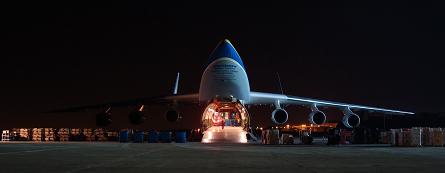
The Mriya landed today morning at the Marcel Dassault airport (France) to bring freight and men to Japan.
It will carry 140 tons of various materials (especially made to work in contaminated environment) such as robots and construction vehicles. The French specialists are made of volunteers and will help their Japaneses counterparts to work on the nuclear power plants.
Update:
Update (28/03/11), lift off of the Mriya from the Marcel Dassault airport.

Source: Nouvelle république.
Posted on:
2011-03-21 under
Mriya.
1 comment
»
Museum of Air and Space of Le Bourget
I wanted to publish a page about the Air and Space museum of Le Bourget for a long time, and here they are the pictures of the space lobby. This museum is the biggest French museum about space exploration, and it is a must see for people you wants to know more about the early French and European space exploration.
This museum is also dedicated to aviation and has some very nice objects like two Concordes and Bleriots.
For the visit of the space lobby it’s here.
Posted on:
2011-01-22 under
Museum.
Commentaires fermés



